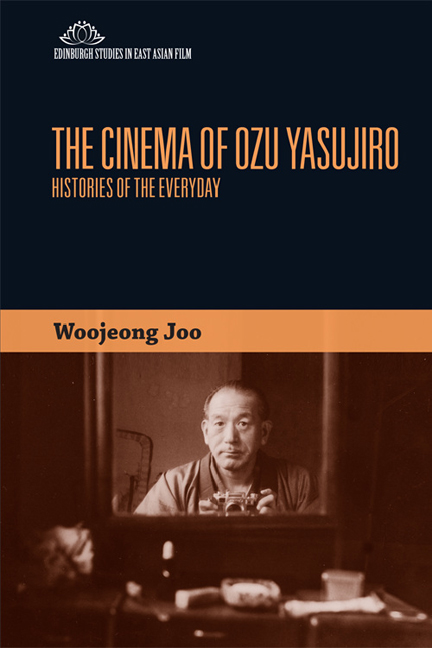Book contents
- Frontmatter
- Contents
- List of Figures
- List of Tables
- Acknowledgements
- Introduction: Ozu, History and the Everyday
- 1 Early Ozu: Shōshimin Film and Everyday Realism
- 2 Ozu in Transition: The Coming of Sound and Family Melodrama
- 3 Wartime Ozu: Between Bourgeois Drama and National Policy Film
- 4 Postwar Ozu: Ozu's Occupation-era Film and Tokyo Regained
- 5 Late Ozu: New Generation and New Salaryman Film
- Conclusion
- Notes
- Glossary of Japanese Terms
- Select Filmography
- Select Bibliography
- Index
Conclusion
Published online by Cambridge University Press: 07 December 2017
- Frontmatter
- Contents
- List of Figures
- List of Tables
- Acknowledgements
- Introduction: Ozu, History and the Everyday
- 1 Early Ozu: Shōshimin Film and Everyday Realism
- 2 Ozu in Transition: The Coming of Sound and Family Melodrama
- 3 Wartime Ozu: Between Bourgeois Drama and National Policy Film
- 4 Postwar Ozu: Ozu's Occupation-era Film and Tokyo Regained
- 5 Late Ozu: New Generation and New Salaryman Film
- Conclusion
- Notes
- Glossary of Japanese Terms
- Select Filmography
- Select Bibliography
- Index
Summary
I have so far explored Ozu's cinema from the perspective of the everyday. Despite the inherent complexity of the concept of the everyday, its relation to the work of Ozu has largely been taken for granted, and has not been given the examination that it deserves. That relation, I think, is not merely confined to the direct impression that viewers get from Ozu's films. Ozu's everyday may seem to be a void; one may choose to point to the silently fl owing cloud shots that are frequently seen in his films in order to assert the ‘emptiness’ of the present, which essentially constructs the everyday. However, arguments such as this often miss out on the more significant point that such shots hardly stand alone in the narrative; the cloud implies the ‘gaze’ of a subject of the everyday (even if absent or elided), and, moreover, a ‘drama’ that has been building to necessitate the gaze. Ultimately, we do not merely respond to the beauty of the scenery Ozu presents us with; we also respond to the feeling it evokes, or a meaning that saturates Ozu's everyday.
In order to conceptualise that abstract affect, I have actively drawn upon the history of Japan and the Japanese film industry in my argument. Within that framework of enquiry, Ozu's everyday becomes a more concrete phenomenon, placed within the context of modern Japanese history. I have articulated the multiplicity of modern life, discussing the differentiated aspects of Japanese modernity, and how a cultural text – a woman's magazine, for example – can reveal the varied perspectives of the modern subject on the everyday. One of the major purposes of this book is to extend this principle of multiplicity to the subjects related to Ozu's cinema, including not only Shochiku and Ozu himself, but also the characters on screen. The result reveals a much more multifaceted topography of Ozu's work, wherein the positions of each subject can be related and compared. I have distinguished the prewar suburban middle classes (shōshimin) from the inner-city lower-middle classes in the Shitamachi district (shomin), whose everyday lives were founded upon different aspects of modernisation – that is, expanding capitalism and pre-modern communalism – although both indicate the same critique of modernity.
- Type
- Chapter
- Information
- The Cinema of Ozu YasujiroHistories of the Everyday, pp. 209 - 215Publisher: Edinburgh University PressPrint publication year: 2017



